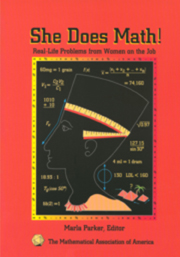Book contents
- Frontmatter
- Preface
- Contents
- Problems by Subject
- Environmental Psychology
- Software Engineering; Computer Science
- Archaeology
- Mathematics and Computer Science
- Civil Engineering
- Mathematics
- Electrical Engineering
- Physics; X-ray Astronomy Research
- Mathematics
- Physics; Astronaut Crew Training Instructor
- Business Data Processing
- Software Engineering; Real Estate Investment
- Quality Engineering
- Health Science
- Nursing Education
- Electrical Engineering; Space Systems
- Oil and Gas Accounting
- Business Administration Higher Education
- Aerospace Engineering
- Structural Engineering
- Computer Science
- Mathematics
- Dietetics—Foodservice Management and Nutrition
- Electrical Engineering
- Chemical Engineering, retired
- Software Engineering
- Immunology and Microbiology
- Mechanical Engineering
- HMO Pharmacy Practice and Management
- Ophthalmology
- Electrical Engineering
- Fish Pathology
- Computer Science and Computer Graphics
- Mathematics and Computing
- Electrical Engineering
- Astronomy
- Author
- Mathematics
- Reflections on WAM
- Solutions
Chemical Engineering, retired
- Frontmatter
- Preface
- Contents
- Problems by Subject
- Environmental Psychology
- Software Engineering; Computer Science
- Archaeology
- Mathematics and Computer Science
- Civil Engineering
- Mathematics
- Electrical Engineering
- Physics; X-ray Astronomy Research
- Mathematics
- Physics; Astronaut Crew Training Instructor
- Business Data Processing
- Software Engineering; Real Estate Investment
- Quality Engineering
- Health Science
- Nursing Education
- Electrical Engineering; Space Systems
- Oil and Gas Accounting
- Business Administration Higher Education
- Aerospace Engineering
- Structural Engineering
- Computer Science
- Mathematics
- Dietetics—Foodservice Management and Nutrition
- Electrical Engineering
- Chemical Engineering, retired
- Software Engineering
- Immunology and Microbiology
- Mechanical Engineering
- HMO Pharmacy Practice and Management
- Ophthalmology
- Electrical Engineering
- Fish Pathology
- Computer Science and Computer Graphics
- Mathematics and Computing
- Electrical Engineering
- Astronomy
- Author
- Mathematics
- Reflections on WAM
- Solutions
Summary
In high school I took all the math classes that were offered: both beginning and advanced algebra, geometry, and trigonometry. Although I planned to major in chemistry, I liked math so well that I switched to chemical engineering, because I thought I would use math more in engineering. In 1948, I received a BS in Chemical Engineering from the University of Minnesota.
For several years, I worked at General Electric, Sylvania, and Stanford Research Institute as an analytical and production chemist. I wanted to learn more math, so I went to San Jose State University and in 1968, earned an MS in Mathematics. Two of my sisters were teachers, and I thought I might like to teach math at a junior college. However, there were no open teaching positions at local junior colleges, so I taught high school algebra and geometry at a private girls' school instead.
I did not enjoy teaching so much as I had hoped, so after three years I returned to engineering, this time at Hewlett-Packard. In my last job before retirement, I was in charge of oxidation-diffusion furnaces in a semiconductor manufacturing facility. When building semiconductor “chips” from silicon, oxides are grown on them. They are then patterned with photolithography equipment to make the various devices: transistors, resistors, and so on. Dopants, such as phosphorous, are diffused into the circuits to make the desired electrical properties. At the end of the process, more oxides are grown to protect the circuits from the outside atmosphere.
- Type
- Chapter
- Information
- She Does Math!Real-Life Problems from Women on the Job, pp. 106 - 107Publisher: Mathematical Association of AmericaPrint publication year: 1995

